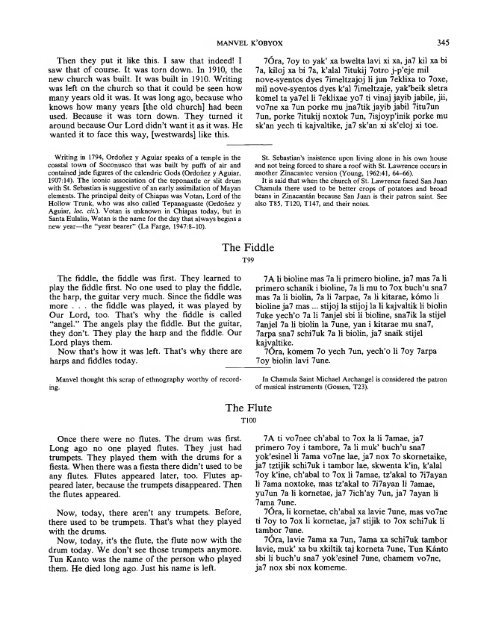PDF (Lo-Res) - Smithsonian Institution Libraries
PDF (Lo-Res) - Smithsonian Institution Libraries
PDF (Lo-Res) - Smithsonian Institution Libraries
Create successful ePaper yourself
Turn your PDF publications into a flip-book with our unique Google optimized e-Paper software.
Then they put it like this. I saw that indeed! I<br />
saw that of course. It was torn down. In 1910, the<br />
new church was built. It was built in 1910. Writing<br />
was left on the church so that it could be seen how<br />
many years old it was. It was long ago, because who<br />
knows how many years [the old church] had been<br />
used. Because it was torn down. They turned it<br />
around because Our <strong>Lo</strong>rd didn't want it as it was. He<br />
wanted it to face this way, [westwards] like this.<br />
Writing in 1794, Ordonez y Aguiar speaks of a temple in the<br />
coastal town of Soconusco that was built by puffs of air and<br />
contained jade figures of the calendric Gods (Ordonez y Aguiar,<br />
1907:14). The iconic association of the teponaxtle or slit drum<br />
with St. Sebastian is suggestive of an early assimilation of Mayan<br />
elements. The principal deity of Chiapas was Votan, <strong>Lo</strong>rd of the<br />
Hollow Trunk, who was also called Tepanaguaste (Ordonez y<br />
Aguiar, be. cit.). Votan is unknown in Chiapas today, but in<br />
Santa Eulalia, Watan is the name for the day that always begins a<br />
new year—the "year bearer" (La Farge, 1947:8-10).<br />
The fiddle, the fiddle was first. They learned to<br />
play the fiddle first. No one used to play the fiddle,<br />
the harp, the guitar very much. Since the fiddle was<br />
more . . . the fiddle was played, it was played by<br />
Our <strong>Lo</strong>rd, too. That's why the fiddle is called<br />
"angel." The angels play the fiddle. But the guitar,<br />
they don't. They play the harp and the fiddle. Our<br />
<strong>Lo</strong>rd plays them.<br />
Now that's how it was left. That's why there are<br />
harps and fiddles today.<br />
Manvel thought this scrap of ethnography worthy of recording.<br />
Once there were no flutes. The drum was first.<br />
<strong>Lo</strong>ng ago no one played flutes. They just had<br />
trumpets. They played them with the drums for a<br />
fiesta. When there was a fiesta there didn't used to be<br />
any flutes. Flutes appeared later, too. Flutes appeared<br />
later, because the trumpets disappeared. Then<br />
the flutes appeared.<br />
Now, today, there aren't any trumpets. Before,<br />
there used to be trumpets. That's what they played<br />
with the drums.<br />
Now, today, it's the flute, the flute now with the<br />
drum today. We don't see those trumpets anymore.<br />
Tun Kanto was the name of the person who played<br />
them. He died long ago. Just his name is left.<br />
MANVEL K'OBYOX 345<br />
The Fiddle<br />
T99<br />
The Flute<br />
T100<br />
7Ora, 7oy to yak' xa bwelta lavi xi xa, ja7 kil xa bi<br />
7a, kiloj xa bi 7a, k'alal 7itukij 7otro j-p'eje mil<br />
nove-syentos dyes 7imeltzajoj li jun 7eklixa to 7oxe,<br />
mil nove-syentos dyes k'al 7imeltzaje, yak'beik sletra<br />
komel ta ya7el li 7eklixae yo7 ti vinaj jayib jabile, jii,<br />
vo7ne xa 7un porke mu jna7tik jayib jabil 7itu7un<br />
7un, porke 7itukij noxtok 7un, 7isjoyp'inik porke mu<br />
sk'an yech ti kajvaltike, ja7 sk'an xi sk'eloj xi toe.<br />
St. Sebastian's insistence upon living alone in his own house<br />
and not being forced to share a roof with St. Lawrence occurs in<br />
another Zinacantec version (Young, 1962:41, 64-66).<br />
It is said that when the church of St. Lawrence faced San Juan<br />
Chamula there used to be better crops of potatoes and broad<br />
beans in Zinacantan because San Juan is their patron saint. See<br />
also T85, T120, T147, and their notes.<br />
7A li bioline mas 7a li primero bioline, ja7 mas 7a li<br />
primero schanik i bioline, 7a li mu to 7ox buch'u sna7<br />
mas 7a li biolin, 7a li 7arpae, 7a li kitarae, komo li<br />
bioline ja7 mas ... stijoj la stijoj la li kajvaltik li biolin<br />
7uke yech'o 7a li 7anjel sbi li bioline, sna7ik la stijel<br />
7anjel 7a li biolin la 7une, yan i kitarae mu sna7,<br />
7arpa sna7 schi7uk 7a li biolin, ja7 snaik stijel<br />
kajvaltike.<br />
7Ora, komem 7o yech 7un, yech'o li 7oy 7arpa<br />
7oy biolin lavi 7une.<br />
In Chamula Saint Michael Archangel is considered the patron<br />
of musical instruments (Gossen, T23).<br />
7A ti vo7nee ch'abal to 7ox la li 7amae, ja7<br />
primero 7oy i tambore, 7a li muk' buch'u sna7<br />
yok'esinel li 7ama vo7ne lae, ja7 nox 7o skornetaike,<br />
ja7 tztijik schi7uk i tambor lae, skwenta k'in, k'alal<br />
7oy k'ine, ch'abal to 7ox li 7amae, tz'akal to 7i7ayan<br />
li 7ama noxtoke, mas tz'akal to 7i7ayan li 7amae,<br />
yu7un 7a li kornetae, ja7 7ich'ay 7un, ja7 7ayan li<br />
7ama 7une.<br />
7Ora, li kornetae, ch'abal xa lavie 7une, mas vo7ne<br />
ti 7oy to 7ox li kornetae, ja7 stijik to 7ox schi7uk li<br />
tambor 7une.<br />
7Ora, lavie 7ama xa 7un, 7ama xa schi7uk tambor<br />
lavie, muk' xa bu xkiltik taj korneta 7une, Tun Kanto<br />
sbi li buch'u sna7 yok'esinel 7une, chamem vo7ne,<br />
ja7 nox sbi nox komeme.

















